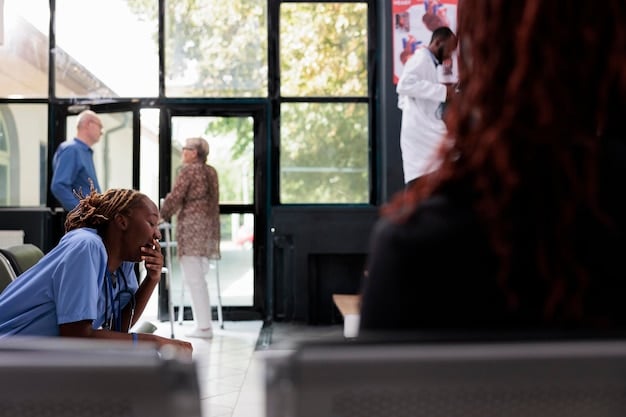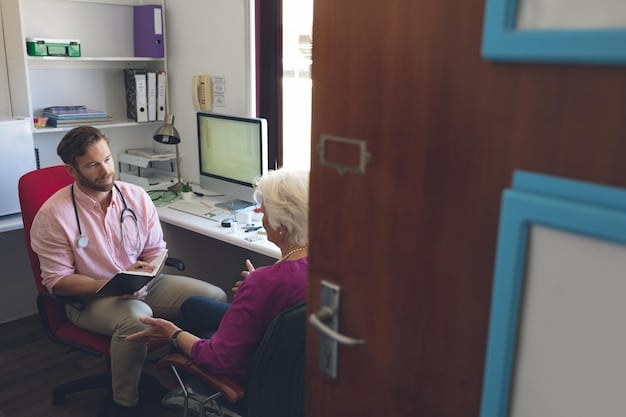Unseen Patients: Socioeconomic Blind Spots in Medical Dramas

The Unseen Patients: Examining the Socioeconomic Factors Ignored by Medical Dramas delves into how medical dramas frequently overlook the crucial socioeconomic factors impacting patients’ health, access to care, and overall outcomes, creating a skewed and unrealistic portrayal of healthcare.
Medical dramas captivate audiences with their high-stakes narratives and portrayals of medical professionals navigating complex cases. However, a critical lens reveals a significant oversight: the socioeconomic factors that profoundly influence patient health and access to care. This article, The Unseen Patients: Examining the Socioeconomic Factors Ignored by Medical Dramas, explores this crucial dimension often missing from our favorite shows.
The Glamorized World of Medical Dramas
Medical dramas have long been a staple of television, offering a thrilling glimpse into the fast-paced world of hospitals and the lives of doctors and nurses. These shows often focus on rare diseases, miraculous saves, and the personal lives of the medical staff.
While entertaining, this often idealized portrayal can create a distorted perception of healthcare, neglecting the everyday struggles faced by patients from disadvantaged socioeconomic backgrounds.

Focus on the extraordinary
Medical dramas commonly highlight the most amazing and uncommon medical conditions. While these instances are exciting, they frequently overshadow the more widespread health issues that are significantly impacted by socioeconomic factors.
Limited Scope of Social Determinants
Shows frequently do not sufficiently address how poverty, bad neighborhoods, lack of acceptable food, and lack of schooling affect affected person’s health.
In reality, social determinants of health account for a sizable portion of patient outcomes.
- Ignoring preventative Care: When programs concentrate entirely on treating illnesses when they arise, they neglect the significance of preventative care.
- Under-representation of Chronic Illnesses: Many people are affected by chronic diseases such as diabetes and hypertension, which are frequently caused by socioeconomic causes.
- The effects of stress and trauma: Shows don’t always adequately depict the effects of stress and trauma, which are more common in low-income populations, on people’s health.
In conclusion, while medical dramas bring drama, they regularly ignore the importance of socioeconomic aspects on patient outcomes. This oversight can lead to a skewed view of healthcare, where the actual battles that so many patients experience are hidden.
Socioeconomic Factors: The Unseen Determinants of Health
Socioeconomic factors encompass a broad range of conditions that significantly influence an individual’s health. These include income, education, employment, housing, access to nutritious food, and neighborhood safety.
These factors often dictate a person’s ability to access healthcare, adhere to treatment plans, and maintain a healthy lifestyle but it’s rarely touched upon in medical dramas.
Impact on Access to Care
Those with lower incomes may find it too difficult to come up with money for medical treatment, prescription drugs, and insurance. This financial barrier can prevent sufferers from receiving prompt medical attention.
Lifestyle and Environmental Factors
Communities with lower socioeconomic status frequently experience high levels of environmental pollutants, bad housing, and insufficient access to healthy foods. These conditions can result in several fitness difficulties with a long lasting effect.
- Poor Nutrition: It can be difficult for lower-income people to purchase nutritious foods, which increases their hazard of developing diabetes, obesity, and heart ailment.
- Unsafe Housing: Exposure to mildew, lead paint, and overcrowding in bad housing can cause or make breathing troubles and lead poisoning worse.
- Lack of Exercise: Those from lower socioeconomic backgrounds may also additionally have fewer possibilities for bodily hobby due to unfavorable neighborhoods and confined access to leisure centers.
In summary, Socioeconomic components have a big impact on someone’s health, affecting the whole lot from get right of entry to care to way of life picks. Medical dramas regularly fail to recognize these determinants, which results in an incomplete picture of the health demanding situations that patients face.
The Ethical Implications of Ignoring Socioeconomic Realities
When medical dramas consistently omit the socioeconomic realities of patients, it raises significant ethical concerns. These omissions can perpetuate harmful stereotypes and contribute to a lack of empathy for vulnerable populations.
By focusing solely on the medical aspects of a case, these shows may inadvertently reinforce the idea that health outcomes are solely determined by individual choices, rather than the systemic barriers faced by marginalized communities.

Reinforcing Negative Stereotypes
When socioeconomic variables are omitted from clinical dramas, negative stereotypes approximately low-income people can be unintentionally bolstered. As an example, patients from despised backgrounds are occasionally portrayed as non-compliant with their treatment plans or as making bad lifestyle choices.
Decreased Empathy
Audiences can also additionally find it more difficult to empathize with sufferers who are experiencing socioeconomic limitations. Clinical dramas can make contributions to public apathy closer to health disparities by way of failing to demonstrate the structural obstacles that sufferers face.
In conclusion, Clinical dramas ought to have ethical considerations as a part of the story-telling technique. Socioeconomic details give context that may lead to deeper appreciation of the challenges of those less wealthy.
Real-World Impact: The Consequences of Misrepresentation
The misrepresentation of healthcare realities in medical dramas can have tangible consequences in the real world. These shows can shape public perceptions, influence policy decisions, and affect the behavior of healthcare professionals.
By ignoring the socioeconomic determinants of health, medical dramas may inadvertently contribute to a lack of understanding and support for policies that address health disparities.
- Public Opinion: The general publics views about healthcare are formed in large part by medical dramas, in particular while humans have little personal revel in.
- Policy Implications: Healthcare guidelines and funding can be negatively impacted by misconceptions and insufficient information.
- Professional Behavior: It is feasible for medical practitioners to be impacted by the ideals and attitudes presented in these programs. A lack of knowledge of socioeconomic realities might cause subpar patient care.
In summary, The depiction of healthcare in medical dramas has a real-global impact. It has the strength to form opinions, have an effect on regulations, and effect the actions of healthcare experts, so it is crucial to precisely reveal socioeconomic factors.
Examples of Socioeconomic Factors in Healthcare
To illustrate the importance of socioeconomic factors in healthcare, consider the following examples. These common scenarios highlight the real-world challenges faced by patients from disadvantaged backgrounds.
These examples also demonstrate how medical dramas often gloss over these critical details, focusing instead on the medical drama itself.
Diabetes Management
A popular drama may show a affected person nicely dealing with their diabetes and getting enough medicines. However, in reality for someone who doesn’t have money for nutritious food to maintain their blood sugar, or who lives in a dangerous neighborhood that makes exercising challenging, managing the situation is extraordinarily hard.
Prenatal Care
Although a show may emphasize critical maternal care, they constantly fail to recognize the challenges that low-income girls experience while seeking prenatal care. Many pregnant girls are unable to get vital prenatal care due to obstacles consisting of a lack of assets, an absence of delivery, or a worry of deportation.
- Mental Health Support: Low-income people may not have get admission to to intellectual healthcare offerings, which makes it more difficult for them to get help for fitness troubles like depression, stress, or trauma.
- Medication Adherence: Patients may have trouble adhering to remedy regimens if they can’t afford their medicinal drugs, lack dependable transportation to get to appointments, or have confined understanding of their contamination.
- Access to Specialists: Low-income sufferers who need specialised care can also have limited alternatives to see specialists, which results in treatment delays or terrible effects.
In conclusion, actual-lifestyles examples make it clear that socioeconomic situations have a huge impact on affected person effects. Medical dramas can extra accurately display the complex demanding situations sufferers face in the healthcare system if they consist of these factors.
Moving Forward: How Medical Dramas Can Improve
Medical dramas have the potential to be powerful tools for education and advocacy. By incorporating socioeconomic factors into their storylines, these shows can raise awareness, challenge stereotypes, and promote empathy.
This would require a conscious effort to move beyond the traditional focus on medical heroics and explore the broader context of patients’ lives.
Consulting with specialists
To make sure their depictions of socioeconomic impacts on health are appropriate and real, clinic dramas could gain significantly from consulting with public health experts, social workers, and community advocates. This helps maintain accuracy and sensitivity to the problems being showed.
Diversify Voices
Shows that consciously variety their writers and producers can contain numerous perspectives and stories with no trouble. Those various perspectives may boost greater genuine depictions of a variety of socioeconomic conditions that affect fitness.
- Show Structural Barriers: Clinical dramas should display systemic obstructions that affect low-income individuals, along with neighborhood violence, environmental risks, and inadequate access to healthcare.
- Emphasize Preventive Care: Instead of completely going for walks on extraordinary interventions and remedies, spotlight preventive care and public health efforts.
- Tell whole Patient Stories: Use show plots to speak about patient’s socioeconomic conditions, now not just their clinical issues.
In summary, medical dramas should consist of socioeconomic factors in their stories to show their impact on fitness. These shows can assist improve audience comprehension and encourage conversations about social change in case they take place to be more inclusive and realistic.
| Key Point | Brief Description |
|---|---|
| 🩺 Healthcare Access | Financial constraints limit access to timely medical care. |
| 🍎 Nutrition Impact | Poor nutrition exacerbates chronic diseases like diabetes. |
| 🏠 Housing Conditions | Unsafe housing leads to respiratory issues and lead poisoning. |
| ⚕️ Mental Health | Lack of mental health support worsens overall health outcomes. |
FAQ
▼
Socioeconomic factors like income, education, and housing significantly impact health outcomes. They affect access to care, nutrition, and safe living conditions, influencing overall well-being.
▼
Medical dramas often focus on rare cases and advanced treatments, neglecting the everyday health issues and socioeconomic challenges faced by many patients in real-world settings.
▼
Examples include lack of access to nutritious food leading to diabetes, unsafe housing causing respiratory problems, and limited access to mental health services affecting overall well-being.
▼
Including these factors can raise awareness, challenge stereotypes, and promote empathy among viewers, leading to a better understanding of health disparities and support for related policies.
▼
By consulting with public health experts, diversifying their writing teams, and showing the systemic barriers that affect low-income individuals, medical dramas can offer a more realistic picture.
Conclusion
In conclusion, medical dramas have a responsibility to accurately portray the complexities of healthcare, including the often-overlooked socioeconomic factors that significantly impact patient outcomes. By embracing these realities, these shows can become powerful tools for education, advocacy, and social change.





